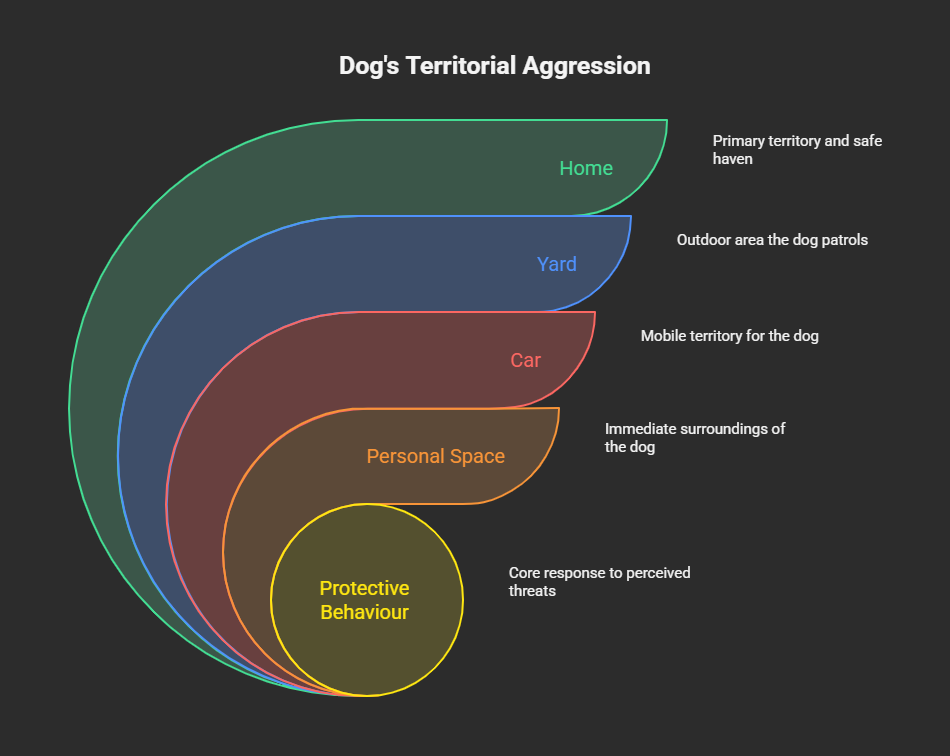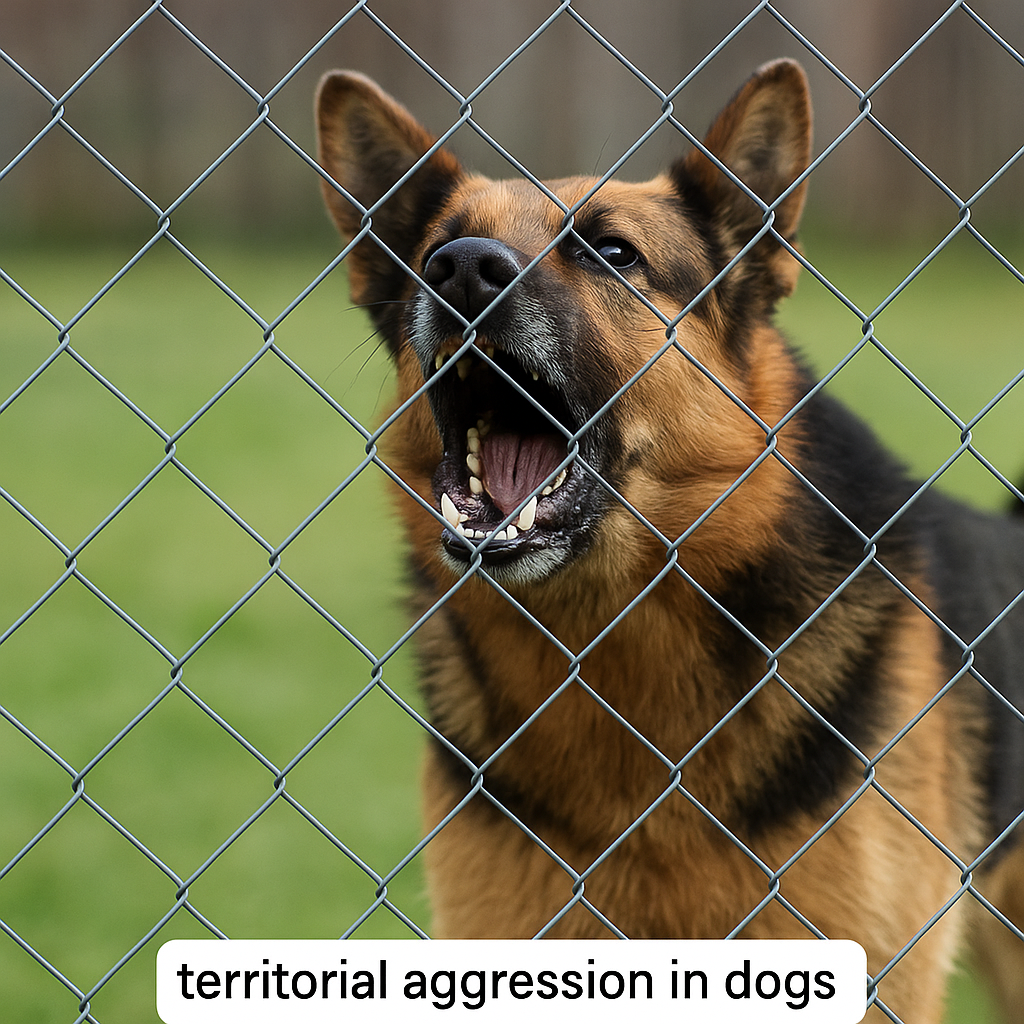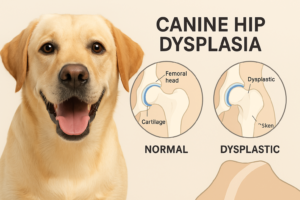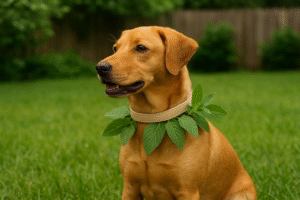Table of Contents
Introduction
Dogs are naturally protective creatures. While some amount of guarding behaviour is normal, territorial aggression {aggression: attack or angry behaviour} occurs when your dog becomes overly defensive {defensive: trying to protect itself or its area} about areas it considers “its space.” If left unmanaged, this behaviour can lead to serious problems — not just for visitors, but for your dog as well.
What Is Territorial Aggression?
Territorial aggression in dogs is a protective behaviour {protective: trying to keep something safe} triggered {triggered: caused to start} when someone (a human or animal) enters an area the dog considers its territory — such as:

- Your home
- The front yard or backyard
- Your car
- The dog’s bed, crate {crate: a box or cage for keeping animals}, or personal space
This reaction is the dog’s way of guarding {guarding: watching and protecting} its perceived {perceived: seen or understood} boundaries. It may start with barking but can escalate {escalate: grow into something more serious} to lunging {lunging: jumping forward suddenly} or biting if not addressed properly.

Territorial aggression in dogs – a German Shepherd barking fiercely behind a fence, showing protective behaviour
Here are the most common behaviours of territorial aggression in dogs:
| Behaviour | What It Means |
|---|---|
| Barking at doors/windows/fences | Warning others to stay away |
| Growling or snarling {snarling: growling while showing teeth} | Feeling threatened {threatened: afraid something bad will happen} or challenged |
| Lunging or jumping at fences | Preparing to chase off intruders {intruders: uninvited persons or animals} |
| Snapping or biting | High-level aggression triggered by fear or protection instinct |
| Standing guard near doors or windows | Alert and ready to respond to anything “unfamiliar” {unfamiliar: unknown or new} |

Several factors may contribute {contribute: lead to or cause} to this type of behaviour:
1. Genetics & Breed Traits
Some breeds (e.g., German Shepherds, Rottweilers, Dobermans) are more prone {prone: likely} to guarding instincts {instincts: natural reactions} due to their working dog backgrounds.
Breeds Known for Territorial Behaviour:
Some breeds are more likely to show territorial aggression, such as:
- German Shepherds – bred as guard and police dogs
- Rottweilers – known for loyalty and guarding ability
- Dobermans – protective of home and family
- Akitas – naturally suspicious of strangers
- Belgian Malinois – intense guarding instincts
⚠️ Note: Not all dogs of these breeds are aggressive — but they may need more training and socialisation.
2. Lack of Early Socialisation
Dogs not exposed {exposed: introduced} to strangers, new environments, or other animals during puppy-hood may see them as threats later in life. Socialisation means exposing a puppy to new people, animals, environments, and situations—especially during the critical period (3–14 weeks of age). This helps the dog learn what’s normal and what’s not threatening.
What happens if a dog isn’t socialised:
When a puppy isn’t properly socialised, it may grow up:
- Fearful or anxious around strangers or unfamiliar situations
- Overly protective of its home, owner, or space
- Unable to distinguish between real threats and harmless visitors
This can lead to territorial aggression, such as:
- Barking or growling at visitors
- Lunging at strangers near the home
- Biting or snapping when someone enters their space
Why Socialisation Prevents This:
Early exposure teaches dogs:
- Confidence in new situations
- That not all strangers are threats
- How to coexist calmly with people and animals
A well-socialized dog might bark once or twice when the doorbell rings but calm down quickly.
A poorly socialised dog may bark excessively, growl, or even bite out of fear-based territorial aggression.
What Owners Can Do:
- Start socializing puppies as early as possible
- Use positive experiences (treats, praise) when meeting new people
- Enroll in puppy socialization classes
- For adult dogs with poor socialization, work with a professional trainer or behaviorist
3. Fear or Anxiety
Aggression sometimes comes from fear — not dominance {dominance: control or power}. A dog may feel unsafe and react to protect itself.When a dog feels fear or anxiety, especially in its own territory (like home or yard), it may become defensive. The dog doesn’t attack to be dominant — it reacts out of fear of a perceived threat.
Common Triggers Include:
- Strangers entering the home or yard
- Loud noises or unexpected movements
- Other animals near their space
- Past trauma or abuse (especially in rescued dogs)
Rescue dogs or those with a rough past may have trust issues and feel the need to defend their space constantly.
Signs of Fear Based Territorial Aggression:
- Growling or barking when someone approaches the house
- Hiding, then suddenly lunging at a perceived threat
- Raised hackles, lowered body posture, tucked tail
- Trying to guard doors, furniture, or the owner
⚠️ These dogs are often not confident—they’re scared and trying to protect themselves or their environment.
How Anxiety Builds Aggression:
Anxious dogs often live in a state of high alert. When someone enters their “safe space,” the anxiety turns into aggressive behavior:
- “Attack first before they hurt me.”
- “I don’t know how to cope with this fear, so I bark or snap.”
How to Help Dogs with Fear-Based Aggression:
- Do not punish — it increases fear.
- Use positive reinforcement to reward calm behavior.
- Provide safe zones (like a crate or quiet room).
- Gradually desensitize the dog to triggers.
- Consult a professional trainer or canine behaviorist.
4. Previous Trauma or Abuse
How to Manage or Treat It
Good news: territorial aggression in dogs can be managed and reduced with time and training.
1. Positive Reinforcement Training
Positive Reinforcement Training is a dog training method that focuses on rewarding good behavior rather than punishing bad behavior. The idea is simple: when a dog does something desirable—like sitting, staying, or not barking—you immediately reward them with something they love (like a treat, praise, petting, or a toy).
How It Works:
Dog performs a good behavior
- → Example: Your dog sits when asked.
You reward the behavior right away
- → Example: You give a treat and say, “Good dog!”
The dog associates the reward with the behavior
- → This makes the dog more likely to repeat the good behavior.
2. Desensitisation
Gradually expose your dog to the things that trigger its aggression — from a safe distance — and pair the experience with treats or praise.Desensitization is a training technique where you slowly expose your dog to something that usually triggers their aggression — but in a controlled, calm, and non-scary way.
- Step 1: You have someone stand far away where the dog notices but doesn’t react.
- Step 2: Reward the dog for staying calm (give a treat or praise).
- Step 3: Over time, move the person a little closer — always rewarding calmness.
Bit by bit, your dog will stop seeing the trigger as a threat.
Important Tips:
- Desensitization must be slow and gradual.
- If you go too fast, the dog may react and lose progress.
- It’s often paired with counter-conditioning changing the dog’s emotional response.
3. Use Physical Barriers
Limit access to windows, gates, or areas that trigger barking. Use curtains, dog gates, or crates when needed. Using curtains, dog gates, or crates can block your dog’s access to strangers. One effective way to manage territorial aggression is to physically block your dog’s access to the things that trigger aggressive behavior — such as people walking past the gate or guests arriving at the door.
4. Give Them a Job
Sometimes dogs just need an outlet {outlet: a way to release energy or feelings}! Mental stimulation {stimulation: mental activity} (toys, scent games) or daily walks help reduce built-up energy. Keep your dog with you during walks and introduce him with strangers from it’s childhood. It will help reduce their fear and build confidence.
Dogs — especially energetic or working breeds — need mental and physical activity. If they get bored, frustrated, or full of unused energy, they are more likely to develop territorial aggression.
So, giving your dog a job means providing tasks or activities that engage their brain and body.
Examples of “Jobs” for Dogs:
- Puzzle Toys
Toys that require your dog to solve something to get a treat. These offer mental stimulation {mental stimulation: ذہنی مشغولیت} and reduce frustration. - Scent Work or Sniffing Games
Hide treats in different places and let your dog find them using its nose. This builds focus and satisfaction. - Basic Obedience Practice
Teach or review commands like sit, stay, down, come — dogs love structure {structure: ترتیب، نظام}. - Daily Walks & New Routes
Changing your walking path occasionally provides new smells and experiences, keeping your dog mentally refreshed. - Dog Sports or Tasks
For highly active dogs: try agility, fetching games, or even giving them a backpack to carry during walks.
Why it Works:
A dog with a “job” is too focused, satisfied, and tired to waste energy on unnecessary aggression. It gives them a sense of purpose.
5. Seek Professional Help
For serious cases, consult a certified dog trainer or animal behaviourist {behaviourist: a person who studies or corrects animal behaviour}. They can design a behaviour modification plan tailored to your dog. If you’re unable to train your dog, seek help from professionals.
https://www.abt-plus.com/faqs-online-dog-training?
What NOT to Do
Don’t punish aggressively
Yelling, hitting, or shock collars may increase fear and make the behaviour worse.
Don’t isolate long-term
A dog that never sees strangers will continue seeing them as a threat. Socialisation is key {key: very important}.
Final Thoughts
Territorial aggression in dogs is not a sign that your dog is “bad” — it’s a sign that they’re unsure or feel unsafe.
Territorial aggression in dogs is a serious behavior issue that can affect the safety of both people and other animals. While it is a natural instinct for many breeds to protect their space, excessive or misdirected aggression must be addressed early and effectively. Understanding the root causes—whether genetic, due to lack of socialization, fear, or anxiety—can help dog owners respond with empathy and appropriate action.
As pet parents, it’s essential to recognize the warning signs such as growling, barking, lunging, or biting when a perceived intruder enters the dog’s territory. These behaviors should never be ignored or punished harshly, as that can worsen the issue. Instead, working with a qualified veterinarian or canine behaviorist can provide a clear diagnosis and a step-by-step behavior modification plan.
Proper training, early socialization, and creating positive associations with strangers or new environments can help reduce territorial tendencies. In some severe cases, medical intervention or behavior therapy may be needed to support your dog’s emotional well-being.
Remember, no dog is aggressive without reason. With patience, consistency, and professional guidance, most dogs can overcome territorial aggression and learn to feel safe and secure without resorting to defensive behavior.
Your dog doesn’t need to be feared—they need to be understood.
By taking the time to learn about your dog’s behavior, you’re not just improving their life—you’re also strengthening the bond of trust and companionship that makes the human-dog relationship so special.
What is territorial aggression in dogs?
Territorial aggression is a protective behavior in dogs triggered when someone enters an area the dog considers its space, such as a home or yard.
Can territorial aggression be treated?
Yes, it can be treated using training methods like positive reinforcement, desensitisation, mental stimulation, and working with a professional behaviorist.
Are some dog breeds more prone to territorial aggression?
Yes. Breeds like German Shepherds, Rottweilers, and Akitas have stronger guarding instincts and may show more territorial behavior if not trained properly.




